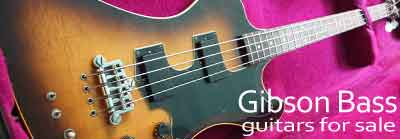The Epiphone Rivoli was manufactured between 1961 and 1968 (excluding 1962, See the Epiphone Rivoli shipping figures) at Gibson's Kalamazoo plant in Michigan, USA. Over the course of production there were some subtle changes in the components fitted to the instrument - most obviously the bridge unit used - but with 1967 being the peak production year, the bass pictured represents the most abundant of all the Rivoli hardware configurations. It is typical for a mid-sixties Kalamazoo plant bass, fitted with chrome-plated hardware throughout: EB humbucker, bar bridge with under-bridge mute, centrally positioned hand rest and Kluson 538 tuning keys. The pale blue Epiphone soundhole label contains the model code, 'EB232C' and the instruments serial number, which is also stamped onto the reverse of the guitar's headstock.
Model: 1967 Epiphone Rivoli EB-232C
Scale: 30 1/2"
Width at Nut:
Neck: One piece set mahogany, rosewood fingerboard. 20 frets. Pearloid dot markers.
Body: Maple top back and sides. Maple center block. Length 19", width 16", depth 1 3/4".
Weight: 4.1kg
Epiphone translucent Cherry finish
The original 1960s Rivoli was available in Sunburst and Natural finishes, with Cherry added in 1966. Just 312 instruments (out of a total US production of 1864) shipped in Cherry between 1966 and 1968. This only amounted to 17% of the total US production. The vast majority of Rivolis had the standard Sunburst finish.
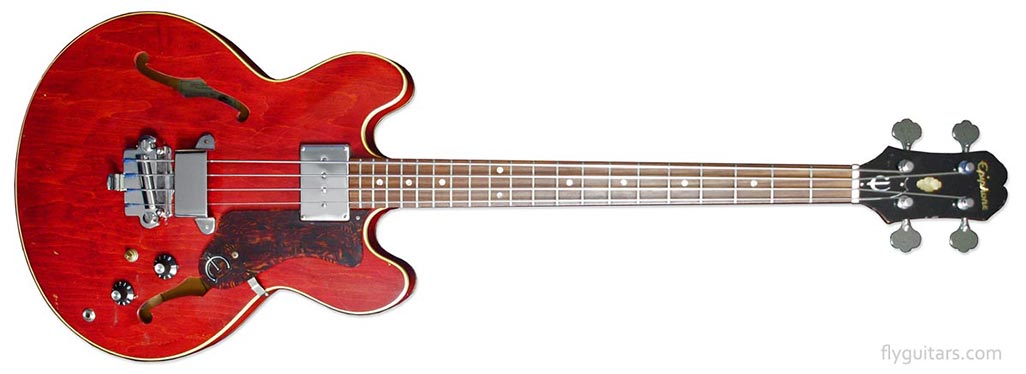
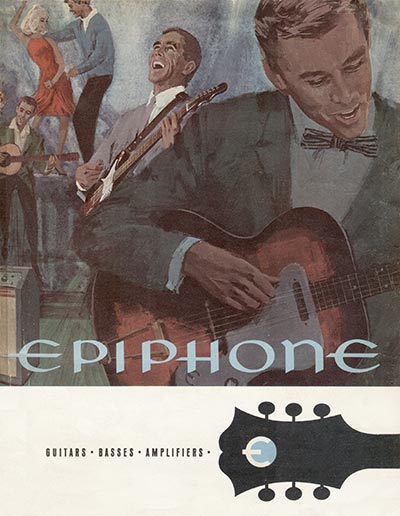
The final catalogue appearance of the Epiphone Rivoli was in the
1966 Epiphone catalog
This is a great sounding bass with the very distinctive, full, Gibson neck humbucker tone. This is obviously a single-pickup instrument, so fat and boomy. Great for certain musical situations, but not all. Dual pickup Rivolis were not available until the model was reissued some 30 years later. 30 1/2" scale basses are great for playing fast runs and quickly changing positions, but short scale strings are essential (I like flatwounds for a real 60's thump - Thomastik-Infeld JF324, Pyramid Gold, and Labella Deep Talkin'). October 1966 prices (the first to include Cherry as a finish option) list Cherry finish at $375; $15 more than Sunburst at $350. By September 1967, either finish was $375. (US zone 1 prices).
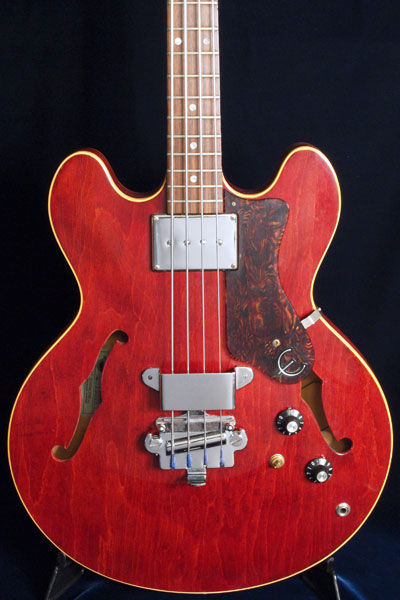
Pickguard aside, the Epiphone Rivoli body and components are identical to the
Gibson EB2; both were made in the Gibson factory in Kalamazoo, Michigan. The maple body is bound front and back, with unbound neck and f-holes. The Epiphone pickguard is quite distinct from those fitted to the EB2, being single ply faux-tortoiseshell with Epiphone 'E' logo and an entirely different shape.
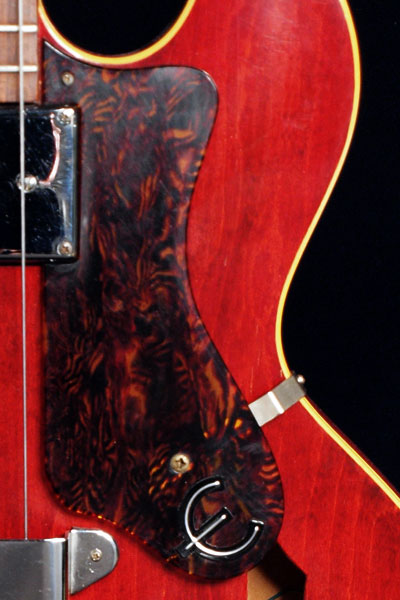
The Rivoli scratchplate has the famous Epiphone 'E' logo; other than the headstock shape and markings, this is the only real difference between the Epiphone Rivoli bass and Gibson EB2 bass.
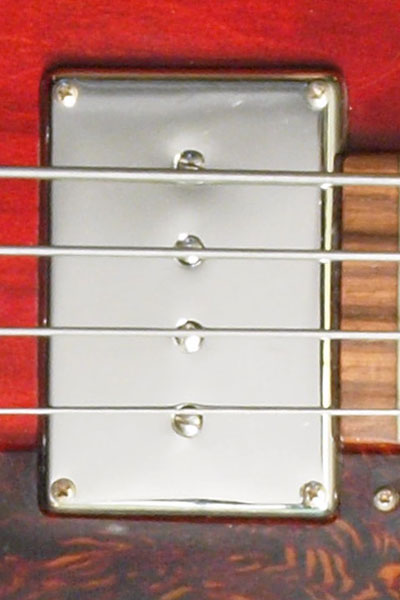
The Epiphone Rivoli bass shared it's hardware with it's equivalent Gibson model, the EB2, with which it was made, side by side, in Kalamazoo. Both basses were fitted with the heavily wound Gibson
EB humbucker - a pickup made famous by it's strong output and resulting low rumbley tones. Like all components, they were subject to change over time - this example has the wider chrome-plated cover, typical of the period 1965-67.
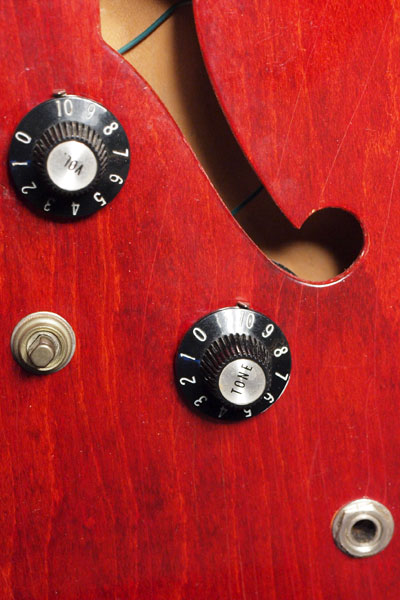
The bass has two rotary controls, each fitted with witch-hat knobs numbered 0-10: volume (top) and tone (bottom). The bush button activates the tone choke.
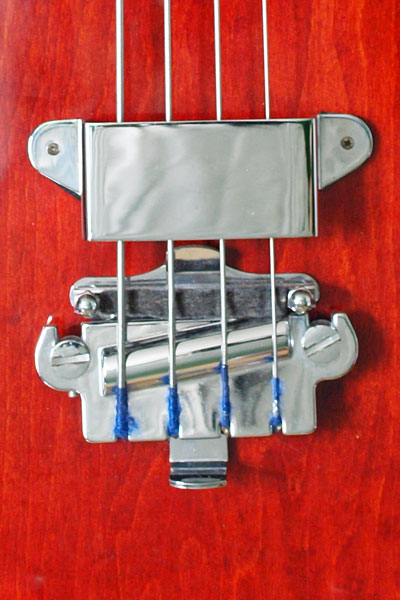
The Epiphone Rivoli was fitted with the same basic hardware as the other Gibson EB basses: the
EB0,
EB2 and
EB3 - plus the Epiphone equivalents: the
Newport. In the period 1965-68 each of these was fitted with the same chrome-plated
hand rest,
bar bridge and
under-bridge mute. The mute is operated by pulling the handle at the far end of the bridge, which in turn pushes up the grey felt pad against the strings, dampening their vibration, giving a more 'upright' bass sound.
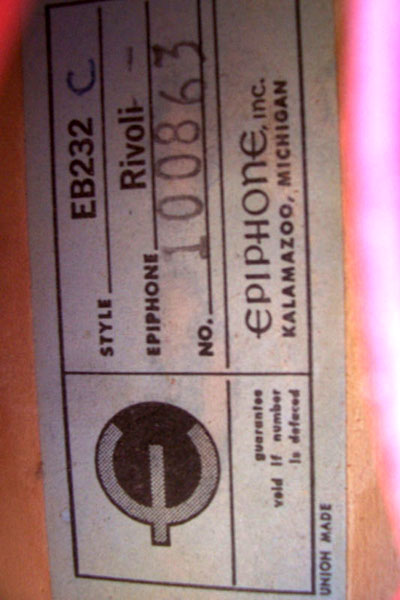
The paper labels glued into Gibson and Epiphone hollow body instruments held the model name (in this case EB232C, where C stands for Cherry finish) and serial number. This serial number also appears on the
headstcok reverse.
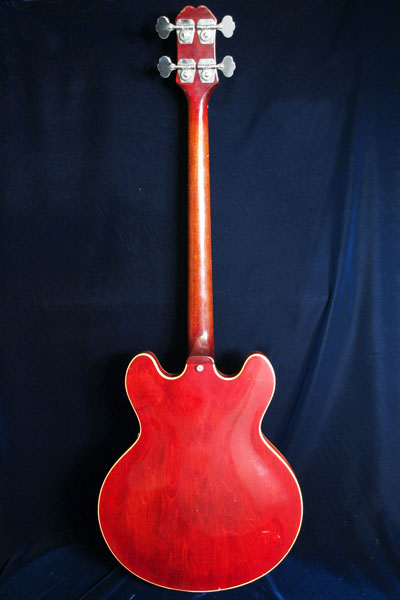
The Epiphone Rivoli, like the EB2, has a maple top, back and sides, but a mahogany neck. When finished in translucent nitrocellulose lacquer the difference in woods can clearly be seen - the lighter coloured maple shows through adding vibrance to the cherry finish, whilst the mahogany tends to mute the red, giving it a more sombre brown hue.
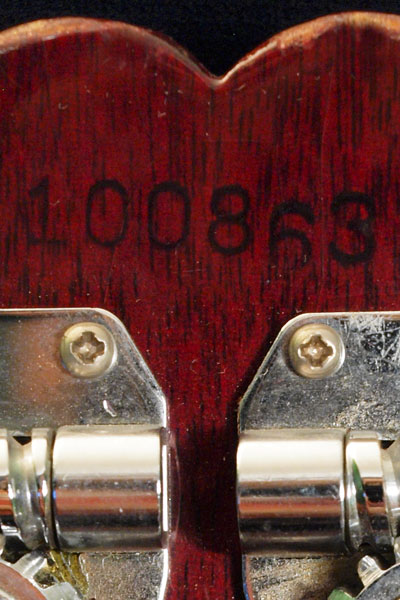
Close up of the serial number stamped into the reverse of the basses headstock. 1950s and 60s Epiphone guitars and basses used the same serial numbering system as the Gibson models with which they were produced.
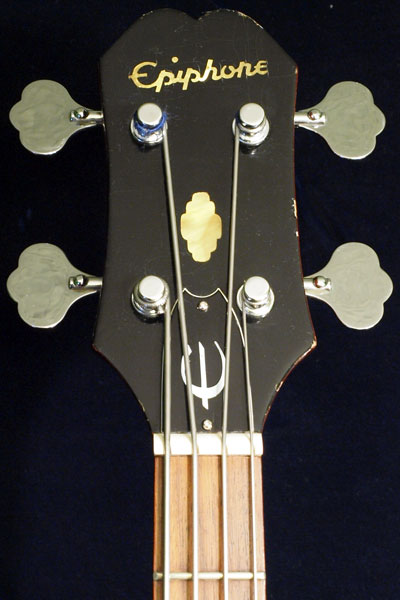
The difference between the Rivoli and EB2 was purely in branding, with Epiphone models having the distinctive 1950s (pre-Gibson) Rivoli mandolin style markings of scripted Epiphone logo, oval inlay and exaggerated curved headstock profile - compare this headstock with one of a similar period
Gibson EB2. Note also the distinctive truss rod cover with Epiphone 'E' logo.
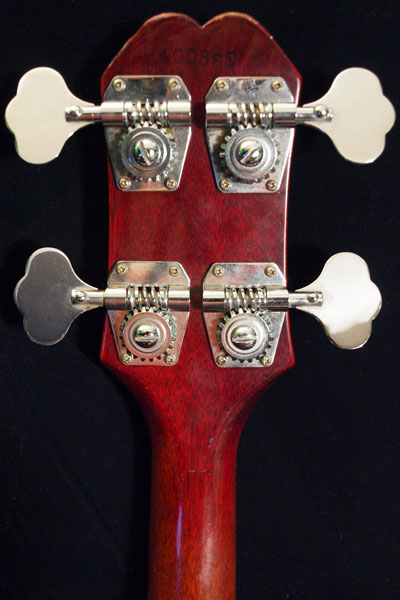
The neck of this bass, as was always the case with Kalamazoo-built Epiphone and Gibson guitars of this period, is produced from a single piece of mahogany. Note the serial number stamped into the top of the headstock. Like the EB2, this bass is fitted with chrome-plated Kluson
538 tuning keys.
Epiphone Rivoli circuitry
The Epiphone Rivoli and the single pickup Gibson EB2 shared the same circuitry: a single pickup, volume and tone control, plus a push-button switch to activate the choke. Have a look at wiring diagram and circuit illustrations. Both potentiometers fitted to this bass have the same value: 500kΩ audio taper part 811-1053, and are CTS brand, with date stamps from the middle of 1967.
Epiphone Newport bass for sale
Flyguitars.com is funded by its visitors. When you buy through links on our site we may earn an affiliate commission. For more info see
terms and conditions.
Wantagh, New York, 117**, UNITED STATES OF AMERICA
$3300
Vintage 1964 Epiphone Gibson EBV232 Rivoli Electric Bass Serial Number 177 522
This rare Vintage Bass is in excellent condition
This Rivoli model remains one the best sounding vintage basses, which I used personally for many genres of performance and recording. This fine bass has been maintained over the years by master craftsman and maker David Segal or New York Bass Works.
The bass comes with a newer Epiphone hardshell case
Please note: This fine instrument will be sold ...
more
Peckville, Pennsylvania, 184**, UNITED STATES OF AMERICA
$3395
The Vintage Reserve at Pristine Auctions is proud to present this awesome 1967 Epiphone Gibson EB-232 Rivoli Electric Bass Serial Number 068624. This is one of the coolest Vintage Basses we have ever encountered at our shop and it is so clean. This thing is honestly one the best sounding vintage basses we have ever had and it is ready for it next show or session in a recording studio. When you press the button, it just takes it to a whole different level of vintage sound. The low end ...
more
Milano, 20***, ITALY
€2950
Epiphone Rivoli EBV232 Vintage Semi-Acoustic Bass . Qualche segno del tempo ma nessun problema strutturale, ottima la action e la suonabilità (c'è comunque margine e modo di personalizzarla come si desidera). Prodotto a Kalamazoo nel 1963 ed originale in ogni sua parte. Manca il suo battipenna ma si trovano ottime repliche anche su eBay
Suono notevole, vero vintage sound!!
Custodia rigida originale compresa
Vendita tra privati con formula AS / IS senza alcun diritto di ...
more
Grimsby, DN32***, UNITED KINGDOM
£1000
The Epiphone Rivoli II Bass Guitar is a high-quality electric bass guitar designed for right-handed players. With a solid body made of wood, a 4-string configuration, a rosewood fretboard, and a maple neck, this guitar boasts excellent sound quality and playability. The sunburst body colour adds a stylish touch to the instrument, making it a great choice for musicians looking for a reliable and versatile bass guitar. The set includes a hard case, making it convenient for players to transport and...
more
London, SW6***, UNITED KINGDOM
£4650
NEW KINGS ROAD VINTAGE GUITAR EMPORIUM IS DELIGHTED TO OFFER FOR SALE THIS
1967 EPIPHONE RIVOLI Bass - EB 232C CHERRY
Incredibly clean, this exceptional condition Epiphone Rivoli was produced by Gibson in their Kalamazoo plant, after Gibson bought the brand in the late 1950s. Identical construction to a Gibson EB2, the only difference being the headstock design and inlays. In a solid 9 out of 10 condition, has a few tiny dings but overall it's in wonderful condition This Rivoli,...
more









